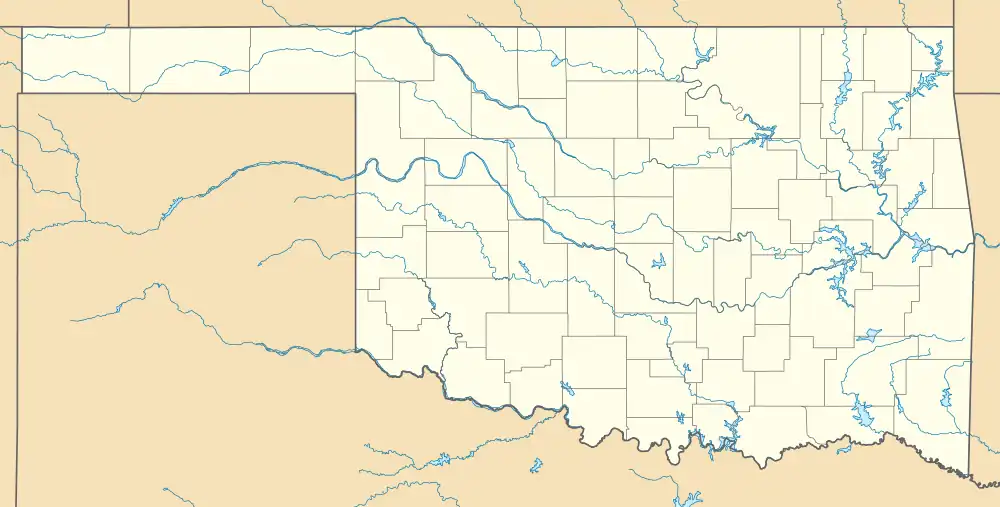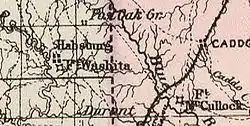Fort McCulloch | |
  | |
| Location | Bryan County, Oklahoma, USA |
|---|---|
| Nearest city | Kenefic, Oklahoma |
| Coordinates | 34°07′53″N 96°23′45″W / 34.13139°N 96.39583°W |
| Built | 1862 |
| NRHP reference No. | 71000659 [1][2] |
| Added to NRHP | June 21, 1971 |
Fort McCulloch was a Confederate military fort built by CSA Brigadier General Albert Pike in the Indian Territory during the American Civil War after the Battle of Pea Ridge.
History
After the southern states seceded from the United States of America, Albert Pike negotiated treaties between the Five Civilized Tribes and the Confederate government, promising that the Confederacy would take over the obligations that the Union failed to fulfill and take over defense for the Indian Territory.[3]
Pike was appointed commander of the Department of the Indian Territory in November 1861. His first assignment was to construct a fort north of Bacone College on the Arkansas River near Muskogee. He named this site Cantonment Davis. However, he and his troops were ordered to leave the site to support the Confederate troops at Pea Ridge. They never returned to Cantonment Davis.[4]
Pike's Native American troops participated in the Battle of Pea Ridge near Leetown, Arkansas in March 1862. The battle was a defeat for the Confederate Army. Pike then considered that his Indian Territory command post at Fort Davis, Cherokee Nation, was vulnerable to a Union attack. He retreated to the Choctaw Nation in southern Indian Territory. Pike chose a site on a bluff on the west side of the Blue River near Nail's Crossing, where he established Fort McCulloch, named for General Benjamin McCulloch, who fell in battle at Pea Ridge.[3]
The site, about 3 miles (4.8 km) southwest of the present-day town of Kenefic, Oklahoma, controlled military roads linking Fort Smith with Fort Washita, Fort Gibson and north Texas. The fort had earthworks, but no permanent buildings. Its importance diminished after Pike resigned his command in July 1862. It was not abandoned until the end of the war. Meanwhile, it served as a haven for pro-Confederate refugees. General Stand Watie used it briefly as a command post in 1865.[5]

Fort McCulloch was built to defend Texas from a Union attack. It had extensive earthworks designed to defend against any advance.[6]
References
- ↑ "National Register Information System". National Register of Historic Places. National Park Service. April 15, 2008.
- ↑ "Oklahoma Historical Society State Historic Preservation Office".
- 1 2 Kidwell, Clara (2008). The Choctaws in Oklahoma: From Tribe to Nation, 1855-1970. Norman, Oklahoma: University of Oklahoma Press. p. 320. ISBN 978-0-8061-4006-3.
- ↑ Morrison, W. B. "Fort McCulloch." In: Chronicles of Oklahoma. Volume 4, Number 3, September 1926. Retrieved January 15, 2014.
- ↑ "May, Jon D. Encyclopedia of Oklahoma History and Culture. "Fort McCulloch."". Archived from the original on 2012-11-19. Retrieved 2008-11-05.
- ↑ Gaines, Craig (1989). The Confederate Cherokees. Baton Rouge, Louisiana: LSU Press. p. 196. ISBN 978-0807127957.
Further reading
- Morrison, W. B. Fort McCulloch Chronicles of Oklahoma 4:3 (September 1926) 216-222
- Fort McCulloch